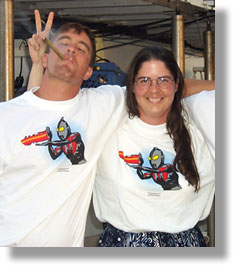| Stephanie Flora
MOBY programmer |
 |
B.S., CSU, Stanislaus
M.S., Moss Landing Marine Laboratories |
| Current Projects: |
Stephanie currently works for the Marine Optical BouY (MOBY) project, which is NASA/NOAA funded. Approximately 50 feet long, the Marine Optical Buoy is the world's largest marine optical device. Under the leadership of Dennis Clark (NOAA), Moss Landing Marine Laboratories' Physical Oceanography group constructed MOBY in 1991 and continues to maintain it at a site 24 km off Lanai, Hawaii. MOBY is an autonomous optical buoy with eight surface and underwater collectors. The underwater collectors are mounted on three arms, each arm with one downwelled irradiance (Ed) and one upwelled radiance collector (Lu). The buoy's primary purpose is to measure visible and near-infrared radiation entering and emanating from the ocean. Measuring ocean color is important because the color of light leaving the sea is determined mainly by phytoplankton, the base of the ocean food chain. These measurements are then compared with satellite measurements made 700 km overhead. MOBY is used to confirm the accuracy of the SeaWiFS (link is external)and MODIS(link is external) ocean color satellite measurements and to obtain a long-term detailed time series of light in the sea. According to Goddard Space Flight Center's Charles McClain, SeaWiFS Project Scientist and Cal/Val Manager, MOBY is the cornerstone of both the MODIS and SeaWiFS Teams' strategy for vicarious calibration of their ocean color satellites.
Stephanie process the daily MOBY data, satellite weighs the data and puts it on the MLML website for NASA to downloaded everyday. Stephanie's other duties are to write and maintain software used to process data from radiometric and other oceanographic instruments used on the project.
|
- Brown, S.W., S.J. Flora, M.E. Feinholz, M.A. Yarbrough, T. Houlihan, D. Peters, Y.S. Kim, J. Mueller, B.C. Johnson, D.K. Clark (2007) The Marine Optical BuoY (MOBY) radiometric calibration and uncertainty budget for ocean color satellite sensor vicarious calibration. Proc. SPIE Optics and Photonics; Sensors, Systems, and Next-Generation Satellites XI. 6744:67441M.
- Yarbrough, M.A., M.E. Feinholz, S. Flora, T. Houlihan, B.C. Johnson, Y.S. Kim, M.Y. Murphy, M. Ondrusek, and D.K. Clark (2007a) Results in coastal waters with high-resolution in-situspectral radiometry: The Marine Optical System ROV. Proc. SPIE Coastal Ocean Remote Sensing. 6680:66800I.
- Brown, S.W., D.K. Clark, B.C. Johnson, H. Yoon, K.R. Lykke, S.J. Flora, M.E. Feinholz, N. Souaidia, C. Pietras, T.C. Stone, M.A. Yarbrough, Y.S. Kim, R.A. Barnes and J.L. Mueller (2004).Advances in Radiometry for Ocean Color.(link is external) in Ocean Optics Protocols for Satellite Ocean Color Sensor Validation, Revision 5, Volume VI: Special Topics in Ocean Optics Protocols, Part 2. J.L. Mueller, G.S. Fargion, and C.R. McClain, Eds. NASA Goddard Space Flight Center, Greenbelt, Maryland 20771. NASA/TM2004-211621/Rev5-Vol.VI:8-35.
- Brown, S.W., B.C. Johnson, S.J. Flora, M.E. Feinholz, M.A. Yarbrough, R.A. Barnes, Y.S. Kim, K.R. Lykke, and D.K. Clark (2003). Stray-light correction of the Marine Optical Buoy(link is external), inOcean Optics Protocols for Satellite Ocean Color Sensor Validation, Revision 4, Volume VI: Special Topics in Ocean Optics Protocols and Appendices. J.L. Mueller, G.S. Fargion, and C.R. McClain, Eds. Greenbelt, MD, NASA Goddard Space Flight Center. NASA/TM2003-211621/Rev4-Vol.VI:87-124.
- Clark, D.K., M.A. Yarbrough, M.E. Feinholz, S. Flora, W. Broenkow, Y.S. Kim, B.C. Johnson, S.W. Brown, M. Yuen and J.L. Mueller (2003). MOBY, a radiometric buoy for performance monitoring and vicarious calibration of satellite ocean color sensors: Measurement and data analysis protocols(link is external), in Ocean Optics Protocols for Satellite Ocean Color Sensor Validation, Revision 4, Volume VI: Special Topics in Ocean Optics Protocols and Appendices. J.L. Mueller, G.S. Fargion, and C.R. McClain, Eds. Greenbelt, MD, NASA Goddard Space Flight Center. NASA/TM2003-211621/Rev4-Vol.VI:3-34.
- Clark, D.K., M.E. Feinholz, M.A. Yarbrough, B.C. Johnson, S.W. Brown, Y.S. Kim and R.A. Barnes (2002). An overview of the radiometric calibration of MOBY. Earth Observing Systems VI. W. L. Barnes, Ed. Bellingham, WA, Society of Photo-Optical Instrumentation Engineers 4483:64-76.
- Yuen, M.A. (2000) Particulate Absorption and CDOM Measurements Coordinated with Ocean Color Imagery. Ocean Optics XV. Monaco, October 16-20.
- Habauzit, C., S.W. Brown, B.C. Johnson, M. Yarbrough, M. Feinholz, and D.K Clark (2000). Radiometric Characterization and Calibration of the Marine Optical System (MOS) For the Marine Optical Buoy (MOBY) Project. Oceans from Space. Venice, Italy, October 9-13.
|


